Today started cooler and although it became uncomfortably hot again as the day wore on there has been a breeze which has helped to make the day bearable.
Although we are generally heading north we decided to revist the Oberlausitz, an area where we had a very happy time together with Hubert and Sigrid many years ago before any of us became parents. So we left Coswig, making our way towards the Saxon Alps via Moritzburg. Ian once visited this picturesque castle, standing in the middle of a lake and reached by a causeway, with Hubert and an American friend Joe nearly forty years ago. Jill had never seen it before.
 Moritzburg from across the lake
Moritzburg from across the lake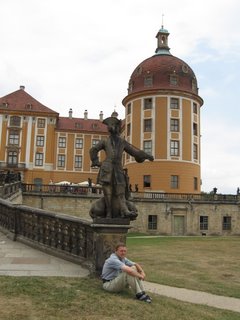 Ian in thoughtful mood at Moritzburg
Ian in thoughtful mood at MoritzburgHe had been photographed on this same spot with friends almost forty years ago
Moritzburg lies about 16 kilometres north of Dresden and was used by the Dukes of Saxony as a hunting lodge during the 17th to 19th centuries, being easily reachable from the court in Dresden. It is a comfortable size to explore fully, leaving time and a little energy for a stroll in the formal gardens and the chance to appreciate the lovely view from the walled terrace out over the surrounding lake with the wooded hillsides beyond. The terrace is decorated with many weathered stone statues of hunters and hunting dogs interspersed with countless little stone cherubs who are into all sorts of mischief from firing guns to carrying off dead ducks and other game. One in particular seemed to have got himself into a particularly uncomfortable predicament.
 Formal garden from terraces, Moritzburg
Formal garden from terraces, Moritzburg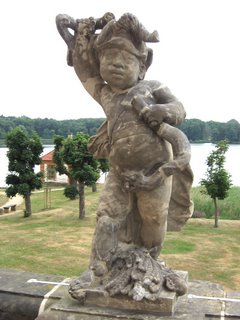 One little chap had a mishap, Moritzburg
One little chap had a mishap, MoritzburgWith apologies to Rolf Harris
We visited the rooms in the castle, which was beautifully decorated and furnished but was most definitely a male establishment with the emphasis on hunting rather than beauty. The walls are all lined with embossed and painted leather and hung with portraits of various dukes and gentlemen of the court. There are also countless paintings of dead birds, wounded stags, wild boar and other game along with lots of blood and savage hunting hounds. The quality of the paintings is not outstanding and the oils so discoloured it is difficult to make out the images. This is probably just as well as there must be a limit to how many gruesome hunting scenes one can see before nightmares set in.
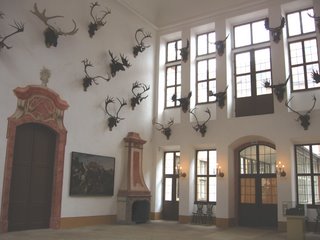 Room in Moritzburg with hunting trophies
Room in Moritzburg with hunting trophiesThe rooms are pleasantly furnished though sometimes the contents of a room seemed to date from a variety of different periods. There is some excellent porcelain ware from Meissen and even earlier examples from China and Japan. Of particular interest is the feather room. Here all the hangings for the bed and the walls are made from carefully selected and dyed ducks' feathers carefully woven into a fabric base. Recent experiments in feather weaving during the lenghty restoration of the room indicate that it is a difficult and time consuming process. Personally we didn't think the end result justified all the work involved.
After a brief lunch of Wiener Würstchen with Brot and Senf (Viennese sausages with bread and mustard) by the castle lake we rejoined Modestine to continue our journey, skirting around Dresden and eventually reaching the first outcrops of the Saxon Alps around 5pm. We are now staying on a site along the banks of the River Elbe, a short distance from the town of Königstein. Once settled we cycled down to explore the town. It didn't take long as there is virtually nothing but a few bars to detain anyone. We were naively surprised to discover the building and roads are at least as dilapidated as they were during the days of the DDR. The town is liable to flooding, the last major occurrence in 2002 being marked on walls throughout the little town, and this partly explains the state of neglect of the lower floors of many buildings, but whereas in West Germany you would be very hard put to it to find anything remotely as dilapidated as here, in Königstein such buildings are regrettably the norm. High above on a sandstone outcrop stands the castle of Königstein, the sides of the rocks covered in fir trees. Around the area are numerous other sandstone outcrops right up to and across into the Czech Republic and Poland. These constitute the Saxon Alps – a national park of outstanding beauty, numerous sandstone hills and deep valleys, heavily wooded and sparsely populated.
This evening we have been able to enjoy supper overlooking the river with a slight breeze that has made life pleasant again. On the opposite bank the dark, tree-clad rock of the Lilienstein rises steeply up to the skyline. As darkness fell we watched and listened as a paddle steamer, full of happy summer visitors, plied its way upriver on an evening cruise, those on deck drinking wine and beer as they listened to music that reverberated from the hills on either side of this narrow passage through the rocks.
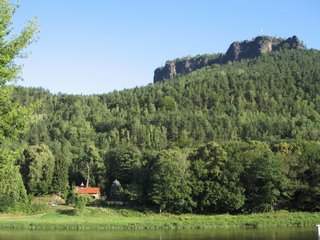 Lilienstein across the Elbe from our campsite in Königstein
Lilienstein across the Elbe from our campsite in Königstein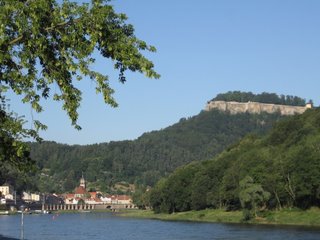 Town and fortress of Königstein
Town and fortress of KönigsteinSaturday 15th July 2006, Waltersdorf, Oberlausitz, East Germany
We have just hung out our washing to dry along the frontiers of Germany, the Czech Republic and Poland. If the wind blows anything off the line overnight it could cause an international incident. Imagine assorted British socks floating over Poland, or Ian's check-bordered shirt turning up on the wrong side of the Czech border!
However, to get down to the business of the day… This morning we again watched craft plying up the river Elbe. This time it was an enormously long barge pulling several others of equal length behind it. It took several minutes to pass and it would be curious to see how they all manage to dock at their destination. The river is obviously navigable from its estuary on the Baltic coast right up into the Czech Republic. Nearby we have seen trains trailing long loaders carrying hundreds of Skoda cars westwards. It seems to be a very profitable Czech success story.
The weather was far more bearable today, bright and hot in the sun but with a breeze and a freshness to the air that was a delight after the past couple of weeks. Deciding we needed some exercise after our recent lethargy we left Modestine in Königstein and climbed the steep uneven track up into the woods that cover the lower flanks of the sandstone rock that towers above the river, the impregnable castle perched on the top. The trees gave cool shade making the ascent a real pleasure. We could stop to admire the scenery down towards the river with its tiny canoes and pleasure boats. We could eat wild raspberries as we climbed, and we were entertained by a continuous chorus of birdsong. When we finally reached the top, an hour later, we were elated. It's the first proper walk we can recall for some time and we had seen nobody on the way up.
 Hilltop fortress, Königstein
Hilltop fortress, Königstein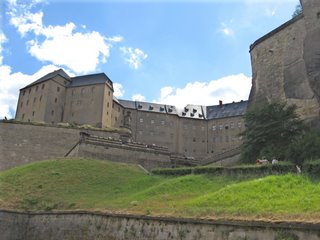 Hilltop fortress, Königstein
Hilltop fortress, KönigsteinAt the top were cars and coaches with queues waiting to enter the grim fortress of a castle. We were really only concerned with the view and it gets very expensive if we go into too many places. So we finally found the former patrol path, a little track that led through woodland around the rocky ledge, just below the cliff on which the castle was perched. It was obviously rarely used and was very overgrown. Our persistence was rewarded with a lovely view down from the sheer edge of the rock where the safety balustrade had been restored in the 1930s and not touched since. It was completely rusted through and dangerously unsafe.
 Clifftop fortifications from the patrol path, Königstein
Clifftop fortifications from the patrol path, Königstein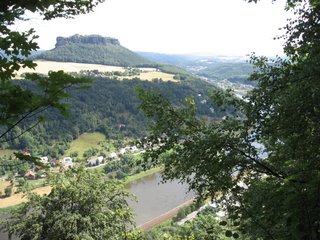 Lilienstein and the Elbe from Königstein
Lilienstein and the Elbe from KönigsteinWhen we finally returned down to Königstein it was lunch time and we saw a little eating place advertising its dish of the day – trout served with potato salad. Trout seems a popular dish around this area, so full of rivers and we succumbed to the temptation, having made ourselves really hungry with our climb. It was delicious, served with iced water to drink in the cool dining room. We were not overjoyed to be watched as we ate by a stuffed stoat, an owl and a buzzard. Nor did the skulls and antlers of stags and the head of a beautiful ibex add greatly to our pleasure. However, this is very much the way things are in rural Europe and we simply have to accept it.
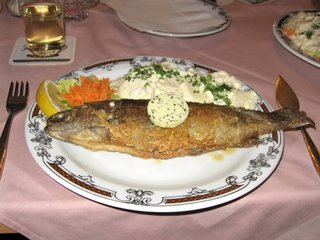 Trout with potato salad, Königstein
Trout with potato salad, KönigsteinAs we mentioned yesterday, we have been making our way to the Oberlausitz, an area of outstanding natural beauty in Saxony that spans the boundaries of three countries. The rolling landscape of golden crops is interspersed by extensive areas of dark shady pine forests and steep sided sandstone outcrops and ravines. Little streams run through the woodland, through tiny villages, and out across the dried meadowlands. With the lack of rain and the heat of the sun recently the landscape is fast becoming dry, dusty and parched, the green grass and flowers seem to have disappeared almost overnight to be replaced by a landscape of golden wheat, some sunflowers and maize.
The style of vernacular architecture in the Oberlausitz does not recognise political boundaries and makes a pleasing contrast to the countless splendid baroque and classical buildings we have visited recently. Within the forests are clearings with little villages and farmsteads, all constructed from wood. They are generally stained black or brown with white window frames. Frequently steps lead up to a gallery along the front with an arched façade beneath. It looks as if the arcaded ground floor was once used for stabling or storage but since built in, though this is only a guess. Certainly many of the houses were used by textile weavers as this was a cottage industry among the Sorbian population of this region. Often they have carved lintels and window sills, picked out in bright red or green. They are surrounded by pretty gardens full of roses and bright flowers making idyllic scenes. Most of the photos included here were taken in the village of Jetrichovice shortly after we crossed again into the Czech area as the shortest way between the part of German Saxony we were leaving and the part we were hoping to reach.
 Arcaded house, Jetrichovice, Czech Republic
Arcaded house, Jetrichovice, Czech Republic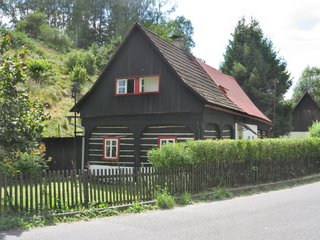 Arcaded house, Jetrichovice, Czech Republic
Arcaded house, Jetrichovice, Czech Republic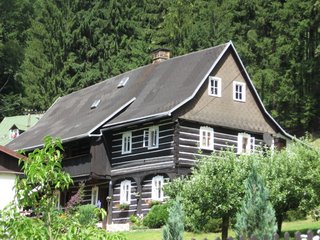 Arcaded house, Jetrichovice, Czech Republic
Arcaded house, Jetrichovice, Czech Republic Rose covered gateway, Jetrichovice, Czech Republic
Rose covered gateway, Jetrichovice, Czech Republic Ian had read that in this area is Pravcická braná (Prebischtor) the largest natural sandstone arch in Europe, set across a gorge in the forests. So we followed narrow, potholed twisting roads up and down through woodland and villages, passing countless weekend cyclists and walkers and trying to understand the Czech fingerposts navigating visitors through the maze of broken woodland roads and tracks. Eventually we reached the nearest point of access to the arch but then realised we had no koronas for the little car park. The young man on duty spoke delightful but incomprehensible Czech to us but was willing to accept payment in euros. However, we also managed to ascertain that it was still a 5 kilometre walk through woodland to reach the arch. The potential for us getting lost without a map and the lack of time we had available decided us against it and we continued towards the border with Germany.
However, we had overlooked the fact that this is a completely forgotten corner of Europe – has anyone reading this ever heard of the Oberlausitz? At the juncture between three former Soviet controlled countries, far from the main centres of population each enclave had lived a lonely and isolated existence until the Change in 1989. Since then roads and communication have not been high on the priorities list of Germany, Poland or the Czech Republic in this area. We found plenty of rural roads leading up to the border with Germany but suddenly there were barricades across the road at the unmanned border. There was no option but to manoeuvre a turnaround on the narrow road and head off to another possible crossing point. Eventually we passed through into Germany at Varnsdorf where again our bikes in bags were looked at with more than the mildest curiosity. Silly really as had we wished to smuggle anyone across it would have been so simple to drop them at one of the unmanned barricades, come through one of the controlled frontier points and drive round to collect our human cargo from the German side.
The tiny town of Seifhennersdorf, starts just a few metres beyond the German-Czech border. It is the place where our friend, Hubert's wife Sigrid, spent her childhood and youth. Sadly she died nearly two years ago but it seemed fitting that we should revisit the area where we had such a happy holiday with her and Hubert many years ago when they were not allowed to visit England and we regularly travelled to the DDR to see them.
Both Hubert and Sigrid lost their fathers in the war and were brought up by their widowed mothers. Sigrid's childhood was thus spent in this very rural village where she and her mother lived with her paternal grandfather. He originally owned a small cigarette factory but it was taken away from the family by the Communist government. It is hard to imagine today how basic and primitive life would have been in such an isolated location tightly bordered on two sides by Czechoslovakia with Poland just to the east, their borders almost engulfing this little area of East Germany. In those days it was impossible to simply cross national boundaries as easily as today, even within the Soviet block countries.
When we visited Sigrid's mother and grandfather here over thirty years ago, we remember the wooden house and the long garden where vegetables were grown to supplement the tedious diet generally available in East Germany. The kitchen cupboard was filled with jars of preserved beans, vegetables and fruit. We went for long walks in the pretty surrounding countryside, rowed a little boat or swam in a nearby lake and arrived back hungry at the house in the evening where somehow Sigrid's mum managed to produce lovely meals for us all to share around the kitchen table with her and granddad as they listened illegally to West German news broadcasts. We did not stay at the house. It would not have been possible. The amount of space a family could occupy was state controlled and in any case, as we were visitors, the police needed to know our movements around the country. So the four of us stayed at the Hotel Cambrinus, the only accommodation in the village. This was basic in the full sense of the word. There was no running water and, believe it or not, the only toilet facility was an extension built out over the stream that ran along the village street. Inside was a seat with a hole directly above a stinking downpipe! We still shudder about it today!
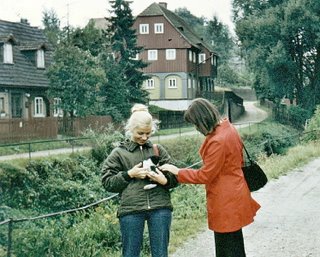 Sigrid and Jill in Seifhennersdorf. A photo taken in 1973
Sigrid and Jill in Seifhennersdorf. A photo taken in 1973When Sigrid's grandfather died her mother moved to Weimar to live with them until she too died. So there is nobody in Seiffhennersdorf today connected with the family and our recollections are very hazy as we never expected to find ourselves back here again. The village has expanded considerably and many of the buildings have been modernised and are quite beautiful. Today children paddle in the stream full of little fishes! Not so when we were last here! Other buildings are in a state of complete neglect, including the place we stayed in so many years ago which is now deserted and a decaying ruin. We did not recognise where Sigrid's home had been but we are very glad we made the visit. It seems to have rounded things off in our minds. Ghosts of three departed friends of successive generations have finally been laid completely to rest. We will almost certainly never visit the town again.
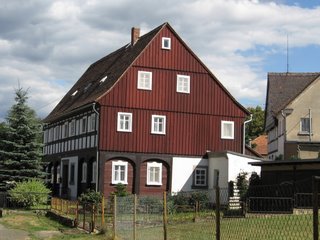 Arcaded house, Seifhennersdorf
Arcaded house, Seifhennersdorf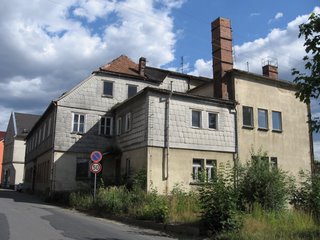 Former Hotel Cambrinus, Seifhennersdorf
Former Hotel Cambrinus, SeifhennersdorfIt was now time to find somewhere for the night. Certainly there was nowhere in Seifhennersdorf, but we eventually found a shaded rural site on a farm where you can be taken around to watch the cows being milked and there are views of the surrounding mountain peaks including the Lausche. One side of this is in Germany and the other in the Czech Republic. We last climbed it with Hubert and Sigrid when we amused ourselves jumping back and forth across the isolated boundary line between the two countries, feeling very brave and wicked! We may stay another day and repeat the walk, if it stays cool and dry. Meantime we have found a washing machine so we have clean clothes blowing on our line. (See opening paragraph for today.)
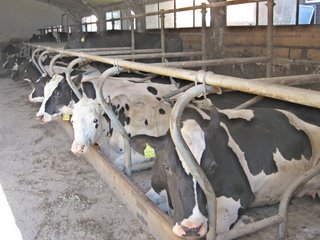 Milking time
Milking timeSunday 16th July 2006, Waltersdorf, Oberlausitz, East Germany
Fortunately the only thing to have blown off the line during the night was Ian's pyjama trousers. By the time we discovered them this morning they were stained a deep red from ripe cherries that had also fallen from the tree above. Good natured as ever Ian declares himself willing to wear exceptionally jolly jamas until the next washload. There is a notice up in the campsite inviting everyone to help themselves to as many cherries as they can eat. The trees are heavy with them and we have been doing our best to lighten their load, so we are now heavy with them too!
We decided to stay another day. It really is so restful and peaceful here and such a refreshing change after the heat and bustle of the streets of Dresden. We spent a relaxed morning lazing beneath one of the cherry trees, sorting out and repacking the contents of Modestine and catching up on editing photos.
After lunch we decided to climb the Lausche. This appears to be volcanic along with numerous others in the region that have forced their way up through the sandstone surface. At 793 metres it is the highest peak in Saxony, offering excellent views of the surrounding countryside from the summit.
We rode Hinge and Bracket as far as possible and continued up the steep, rocky path through woodland on foot. The going was exhausting but the trees gave welcome shade and from a little village on the plain below the sounds drifted up of a brass band playing "Roll out the Barrel" and other jolly oompah tunes which helped us to keep up a steady pace. We had the woodland to ourselves and the views through the trees became increasingly spectacular as we slowly climbed our way up. Eventually our woodland track joined a broader route up from the Czech/German frontier post with a steady flow of weary walkers making their way to the summit. At the top we could see around in every direction. The barbed wire that had marked the boundary between the two countries on our last visit has now disappeared and people were wandering around on both sides of the summit in the warm bright sunshine that gave a clear light over the surrounding landscape.
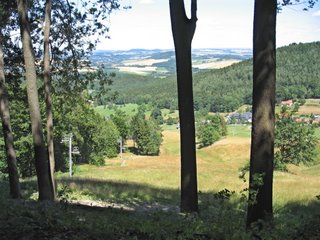 View from the woodland footpath up the Lausche
View from the woodland footpath up the Lausche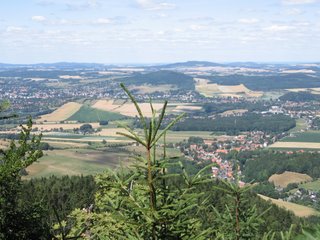 Countryside and little villages around the Lausche
Countryside and little villages around the Lausche Surrounding volcanic peaks from the summit of the Lausche
Surrounding volcanic peaks from the summit of the Lausche Ian on the boundary stone between Germany and the Czech Republic on the Lausche
Ian on the boundary stone between Germany and the Czech Republic on the LauscheWe decided to return along the track down to the unmanned border post and take the easier route along the road back to our bikes. On the way we passed through the village with the brass band. That had finished now but the large beer tent on the green was still going strong with a DJ playing typical noisy German music interspersed with typical German jokes that caused much ribald mirth amongst the listeners. We joined the happy crowds on long wooden benches at long wooden tables and ordered glasses of wine and beer with a large plate of chips and tomato sauce. We spent a really lovely hour or so watching everyone enjoying themselves. Older couples danced to the band, children had their faces painted and everyone looked happy as they ordered yet more tankards of beer, Bratwurst and plates of cheesecake.
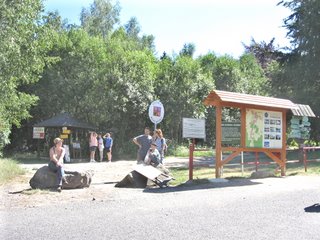 Czech frontier post below the Lausche
Czech frontier post below the Lausche Barmaid in the beer tent, Waltersdorf village fête
Barmaid in the beer tent, Waltersdorf village fête Jill enjoys Ian's beer, Waltersdorf village fête
Jill enjoys Ian's beer, Waltersdorf village fête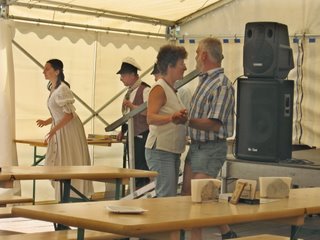 Dancing at Waltersdorf village fête
Dancing at Waltersdorf village fêteWe took part in a wheel of fortune raffle. Each time the wheel stopped turning somebody would win a plate of freshly-baked cakes. Somehow our number never came up but for the sake of our waistlines it was probably as well. It was fun just taking part and good German number practice for Jill each time they were called out. The village ladies had learnt a lively, coordinated dance routine which they performed to the usual rhythmic German music everyone so loves here.
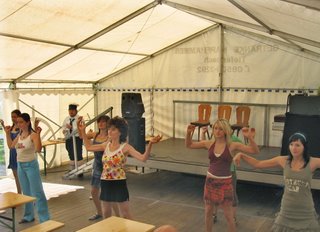 Cabaret by the local WI, Waltersdorf village fête
Cabaret by the local WI, Waltersdorf village fêteWe really enjoyed the time spent in the beer tent. Everyone was having so much fun, many dressed in silly hats and long shorts that made them look rather like quaint garden gnomes. Nobody bothered about us joining in with them. Maybe they never realised we were not German. Ian's command of the language really is impressive and frequently at campsites it has only been realised that he is English when our passports need to be shown.
 Our Master of Ceremonies, Waltersdorf village fête
Our Master of Ceremonies, Waltersdorf village fêteWe continued down the hill to the bottom of the village street, passing traditional wooden houses with their pretty gardens.
 Wooden houses with the Lausche behind, Waltersdorf
Wooden houses with the Lausche behind, Waltersdorf 18th century house in wood and stone with exceptionally pretty garden, Waltersdorf
18th century house in wood and stone with exceptionally pretty garden, Waltersdorf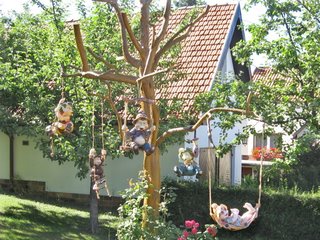 Recent house with exceptionally tacky garden, Waltersdorf
Recent house with exceptionally tacky garden, WaltersdorfAt the bottom we collected our bikes and returned to the campsite and Modestine. While Jill organised supper Ian enjoyed chatting with some of the other campers. We have been warned school holidays start next week and to avoid coastal campsites as we head up towards the Baltic.
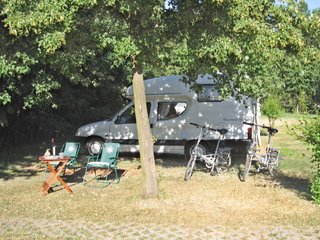 Modestine welcomes us back to a shady spot on the campsite, Waltersdorf
Modestine welcomes us back to a shady spot on the campsite, Waltersdorf